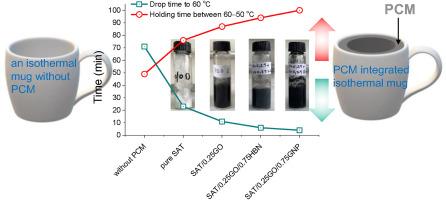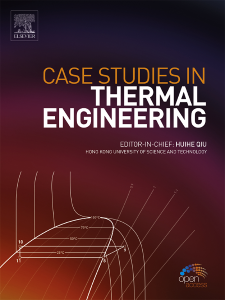Optimizing thermal performance of sodium acetate trihydrate phase-change-materials through synergistic effects of binary graphene nanoadditives for prolonged hot beverage maintenance
IF 6.4
2区 工程技术
Q1 THERMODYNAMICS
引用次数: 0
Abstract
Sodium acetate trihydrate (SAT) is a promising candidate for thermal energy storage due to its high latent enthalpy and economic viability. However, limitations like supercooling and low thermal conductivity hinder its practical application. Herein, these challenges are addressed by developing a novel SAT-based composite phase change material (PCM) through incorporation of binary nanoadditives—graphene oxide (GO) and graphene nanoplatelets (GNP) to mitigate supercooling and enhance thermal conductivity, respectively. Notably, the optimal composite, SAT/0.25GO/0.75GNP, identified through systematic formulation optimization, retains a high latent enthalpy (281.09 J/g), comparable to pure SAT (290.47 J/g), with improved thermal conductivity and substantially reduced supercooling and phase separation issues. The combined effects of GO and GNP, likely due to noncovalent interactions, enhanced heat transfer in the composite, which was further tested in a vacuum mug. The SAT/0.25GO/0.75GNP composite achieved ideal drinking temperatures (60–50 °C) for hot water in just 4 minutes–18 times faster than the PCM-free control mug and 6 times faster than the Mug containing pure SAT. While the PCM-free mug maintains hot water within this interval for only 49 min, MugPCM, encapsulating pure SAT, retains heat for 76 min, and that with SAT/0.25GO/0.75GNP keeps remarkably hot for as long as 100 min.

通过二元石墨烯纳米添加剂的协同效应优化三水醋酸钠相变材料的热性能,以延长热饮保持时间
三水醋酸钠(SAT)因其高潜焓和经济可行性而有望成为热能储存的候选材料。然而,过冷和低导热性等限制因素阻碍了它的实际应用。在本文中,通过加入二元纳米添加剂--氧化石墨烯(GO)和石墨烯纳米颗粒(GNP),开发出一种新型的基于 SAT 的复合相变材料(PCM),以分别缓解过冷和提高热导率,从而解决这些难题。值得注意的是,通过系统配方优化确定的最佳复合材料 SAT/0.25GO/0.75GNP 能保持较高的潜热焓(281.09 J/g),与纯 SAT(290.47 J/g)相当,同时还能提高热导率,大幅减少过冷和相分离问题。GO 和 GNP 的共同作用(可能是由于非共价相互作用)增强了复合材料的传热性,并在真空杯中进行了进一步测试。SAT/0.25GO/0.75GNP 复合材料只需 4 分钟就能达到理想的热水饮用温度(60-50 °C)--比不含 PCM 的对照杯子快 18 倍,比含有纯 SAT 的杯子快 6 倍。不含 PCM 的水杯在此区间内保持热水的时间仅为 49 分钟,而封装了纯 SAT 的 MugPCM 可在 76 分钟内保持热量,封装了 SAT/0.25GO/0.75GNP 的水杯可在 100 分钟内保持热量。
本文章由计算机程序翻译,如有差异,请以英文原文为准。
求助全文
约1分钟内获得全文
求助全文
来源期刊

Case Studies in Thermal Engineering
Chemical Engineering-Fluid Flow and Transfer Processes
CiteScore
8.60
自引率
11.80%
发文量
812
审稿时长
76 days
期刊介绍:
Case Studies in Thermal Engineering provides a forum for the rapid publication of short, structured Case Studies in Thermal Engineering and related Short Communications. It provides an essential compendium of case studies for researchers and practitioners in the field of thermal engineering and others who are interested in aspects of thermal engineering cases that could affect other engineering processes. The journal not only publishes new and novel case studies, but also provides a forum for the publication of high quality descriptions of classic thermal engineering problems. The scope of the journal includes case studies of thermal engineering problems in components, devices and systems using existing experimental and numerical techniques in the areas of mechanical, aerospace, chemical, medical, thermal management for electronics, heat exchangers, regeneration, solar thermal energy, thermal storage, building energy conservation, and power generation. Case studies of thermal problems in other areas will also be considered.
 求助内容:
求助内容: 应助结果提醒方式:
应助结果提醒方式:


